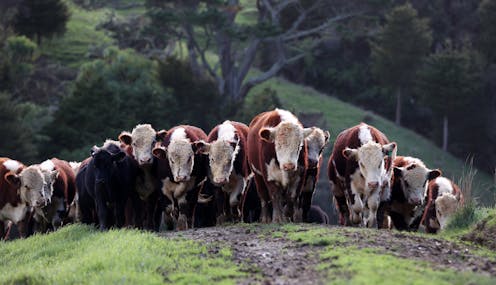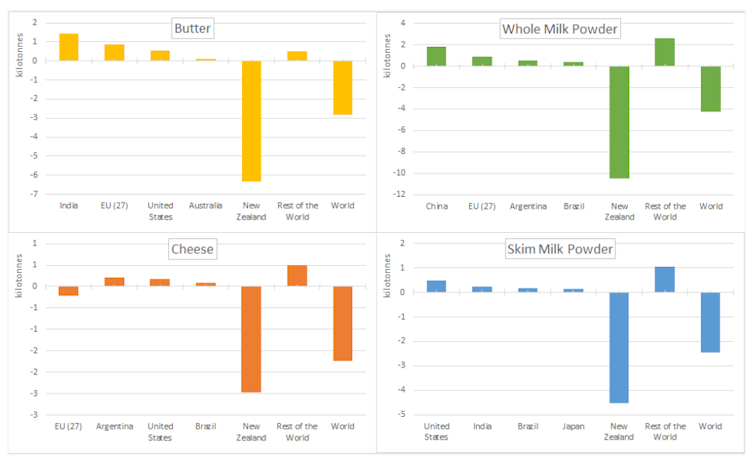
The recent report issued by the Intergovernmental Panel on Climate Change (IPCC) underscores the urgency of emissions reductions. For Aotearoa New Zealand, where 50% of emissions come from agriculture in the form of methane and nitrous oxide, this means the primary sector must be part of the response.
New Zealand is indeed the first country to investigate introducing a price on agricultural greenhouse gas emissions.
The most recent pricing proposals would require farmers to pay a levy on their agricultural emissions. To begin with, only 5% of emissions would be priced, with proposals to reduce the 95% free allocation gradually over time.
Much of the existing modelling shows emissions could be cut by up to 10% by reducing the intensity of production, often through lowering animal numbers and fertiliser use. This doesn’t necessarily mean lower profitability. With good pasture management, farmers may be able to reduce stocking rates and increase profits.
But Aotearoa is already one of the most efficient producers of meat and dairy products globally. If we reduce emissions here, will that not simply lead to other, less efficient countries picking up the lost production, while our farmers pay the price?
This idea is known as “carbon leakage” and is often used as an argument against any domestic policy that could result in reduced agricultural production. The issue is important as New Zealand depends heavily on agricultural exports. In 2022, of all merchandise trade, 65% were agricultural commodities.
Understanding whether carbon leakage will occur or not is a complex task. Here, we look at what evidence we have and insights from agricultural trade modelling.
New Zealand modelling
It’s difficult to know exactly what might happen in agriculture, as emissions pricing on agricultural products has not yet been used elsewhere. There is no historical evidence to draw on.
International modelling studies present a mixed picture of the likelihood of leakage: an OECD study estimated 34% of agricultural emissions would be leaked, mostly to developing countries.
Recent modelling for New Zealand examines a series of scenarios of domestic pricing on its own as well as international pricing. The results show that for the current proposal where only 5% of emissions are priced to begin with, with a 1% increase each year, New Zealand’s production of meat and dairy products could decline by 2050.
The effect on dairy producers would be a loss of returns of under 1%, while meat producers would face a 6% decline. Some of the production would be taken up by other countries, but the overall volume would be lower than in the baseline situation, where no emissions pricing existed.

This shows leakage may occur, with reductions in production of New Zealand dairy products. But global meat and dairy production by 2050 would be considerably lower than without the policy, which would have a positive overall impact on the climate.
As the proportion of emissions that are priced increases, we expect the quantity of meat and dairy produced in New Zealand to decrease. This in turn could increase the volume of leakage. –
More sustainable future diets
It is important to remember that although there is a reduction in meat and dairy production, there is likely to be an increase in the production of other types of food which doesn’t contribute so much to climate change.
A recent study shows how food consumption alone could contribute an additional degree of warming above preindustrial temperatures by 2100. This demonstrates the importance of food choices in addressing climate change.
Read more: If we perfect cultivated meat, we could hedge against food shortages as climate chaos intensifies
Many of New Zealand’s trading partners are exploring and beginning to implement their own agricultural emissions-reduction goals and targets. Internationally, there is an increasing focus on the role international trade rules can play in addressing climate change, including border carbon adjustment mechanisms and environmental standards for imports.
In a similar scenario as described above, but where New Zealand’s main competitors also take action, New Zealand may actually see a small increase in production by 2050, despite the domestic pricing policy.
The extent of leakage therefore really depends on how other countries tackle their own emissions. Economy-wide net zero emissions targets are in place for Australia, Chile, European Union countries, the US and the UK by 2050, and for China by 2060.
The opportunity for leakage would be significantly reduced through multilateral agreements or through regional or bilateral commitments within trade agreements.
Read more: What if carbon border taxes applied to all carbon – fossil fuels, too?
New Zealand could decide to be a leader and demonstrate to the rest of the world a commitment to reducing emissions from our highest emitting sector. This may result in some leakage initially, but this would likely decline as other countries take similar action.
Or we can wait until other countries begin to take more serious action on agricultural emissions. But in the meantime, emissions reductions will increasingly be driven through finance and private-sector initiatives, for example through access to processing companies, which are progressively requiring emissions reductions throughout their value chains and through lending and finance, where banks are beginning to offer reduced interest rates for sustainable practices.
The authors do not work for, consult, own shares in or receive funding from any company or organization that would benefit from this article, and have disclosed no relevant affiliations beyond their academic appointment.
This article was originally published on The Conversation. Read the original article.




!["[T]he First and Fifth Amendments Require ICE to Provide Information About the Whereabouts of a Detained Person"](https://images.inkl.com/s3/publisher/cover/212/reason-cover.png?w=600)


